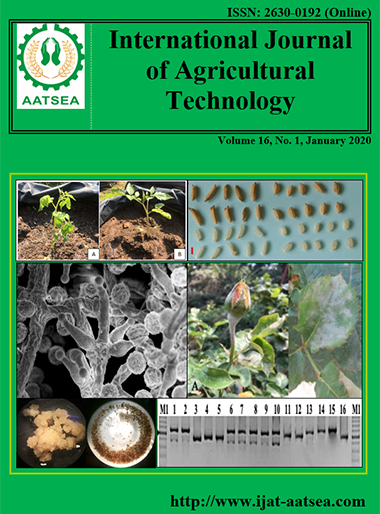Application of seed coating with endophytic bacteria for Fusarium wilt disease reduction and growth promotion in tomato
Main Article Content
Abstract
Tomato seed coating with endophytic bacteria (SuRW02) was used to control Fusarium wilt disease of tomato and stimulated plant growth in field conditions. Results showed that seed coating with isolate SuRW02 reduced disease incidence and severity which similar to seed coating with chemical fungicide (Captan). Seed coating with endophytic bacteria and Captan showed disease incidences of 38 and 25% and disease severity indices of 0.37 and 0.25, respectively. Uncoated seeds and seed coating without endophytic bacteria had a disease incidences of 70 and 50% and disease severity indices of 2.00 and 1.25, respectively. In addition, seed coating with endophytic bacteria promoted tomato plant growth and quality of tomato production.
Article Details

This work is licensed under a Creative Commons Attribution-NonCommercial-NoDerivatives 4.0 International License.
References
Abdallah, R. A. B., Mokni-Tlili, S., Nefzi, A., Jabnoun-Khiareddine, H. and Daami-Remadi, M. (2016). Biocontrol of Fusarium wilt and growth promotion of tomato plants using endophytic bacteria isolated from Nicotiana glauca organs. Biological Control, 97:80-88.
Ahmed, A. I., Yadav, D. R. and Lee, Y. S. (2016). Applications of nickel nanoparticles for control of Fusarium wilt on lettuce and tomato. International Journal of Innovative Research in Science, Engineering and Technology, 5:7378-7385.
Glick, B. R. (2012). Plant Growth-Promoting Bacteria: Mechanisms and Applications. Scientifica, pp.16.
Hu, X., Roberts, D. P., Maul, J. E., Emche, S. E., Liao, X., Guo, X. and Liu, S. (2011). Formulations of the endophytic bacterium Bacillus subtilis Tu-100 suppress Sclerotinia sclerotiorum on oilseed rape and improve plant vigor in field trials conducted at separate locations. Canadian Journal of Microbiology, 57:539-546.
Kaewkham, T. (2017). Seed enhancements with plant growth promoting bacteria. Khon Kaen Agriculture Journal, 45:197-208.
Kaewkham, T., Hynes R. K. and Siri, B. (2016). The effect of accelerated seed ageing on cucumber germination following seed treatment with fungicides and microbial biocontrol agents for managing gummy stem blight by Didymella bryoniae. Biocontrol Science and Technology, 26:1048-1061.
Kasem, S., Kumkongkaew, P., Boonkeat, W. and Prathuangwong, S. (2011). New microbial products for seed storage and field application against bacterial leaf streak of sweet corn. Proceedings of the 35th National Corn and Sorghum Research Conference 2011, Bangkok, Thailand, November 24-27, 2014, 198-205.
Khan, A. L., Waqas, M., Kang, S. M., Al-Harrasi, A., Hussain, J., Al-Rawahi, A. and Lee, I. J. (2014). Bacterial endophyte Sphingomonas sp. LK11 produces gibberellins and IAA and promotes tomato plant growth. Journal of Microbiology, 52:689-695.
Kipngeno, P., Losenge, T., Maina, N., Kahangi, E. andJuma, P. (2015). Efficacy of Bacillus subtilis and Trichoderma asperellum against Pythium aphanidermatum in tomatoes. Biological Control, 90:92-95.
Marlatt, M. L., Correll, J. C., Kaufmann, P. and Cooper, P. E. (1996). Two genetically distinct populations of Fusarium oxysporum f.sp. lycopersici race3 in the United States. Plant Disease, 80:1336-1342.
Nandhini, S., Sendhilvel, V. and Babu, S. (2012). Endophytic bacteria from tomato and their efficacy against Fusarium oxysporum f.sp. lycopersici, the wilt pathogen. Journal of Biopesticides, 5:178.
Noel, T. C., Sheng, C., Yost, C. K., Pharis, R. P. and Hynes, M. F. (1996). Rhizobium leguminosarum as a plant growth promoting rhizobacterium: direct growth promotion of canola and lettuce. Canadian Journal of Microbiology, 42:279-283.
Patel, H. A., Patel, R. K., Khristi, S. K., Parikh, K. and Rajendran, G. (2012). Isolation and characterization of bacterial endophytes from Lycopersicon esculentum plant and their plant growth promoting characteristics. Nepal Journal of Biotechnology, 2:37-52.
Prasom, P., Sikhao, P. and Koohakan, P. (2017). In Vitro Study of Endophytic Bacteria Isolated from Tomato Plant against Fusarium oxysporum. International Journal of Agricultural Technology, 13:1217-1230.
Prasom, P., Sikhao, P. and Koohakan, P. (2018). Tomato seed coating with endophytic bacteria for control Fusarium disease. The National Horticultural Conference 17th. Chiangmai Grandview&Convention Center, ChiangMai, Thailand, November 19-21, 2018.
Ryan, R. P. Germaine, K., Frank, A., Ryan, J. D. and Dowling, D. N. (2008). Bacterial endophytes: recent development and application. FEMS Microbiology Letter, 278:1-9.
Shahab, S., Nuzhat, A. and Nasreen, S. K. (2009). Indole acetic acid production and enhanced plant growth promotion by indigenous PSBs. African Journal of Agricultural Research, 4:1312-1316.
Shweta, B., Maheshwari, D. K., Dubey, R. C., Arora, D.S., Bajpai, V. K. and Kang, S. C. (2008). Beneficial effects of Fluorescent pseudomonads on seed germination, growth promotion, and suppression of charcoal rot in groundnut (Arachis hypogea L.). Journal of Microbiology and Biotechnology, 18:1578-1583.
Zohora, U. S., Ano, T. and Rahman, M. S. (2016). Biocontrol of Rhizoctonia solani K1 by iturin A producer Bacillus subtilis RB14 seed treatment in tomato plants. Advances in Microbiology, 6:424.


